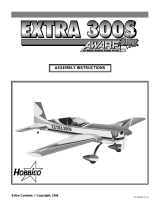Page is loading ...

CARF-Models JOKER
Preliminary Setup Manual
Dear Customer,
the full Joker Manual is in the works. Since this might take a while to complete, here a few notes
how to do the important build steps, which we think could need some additional info, and how to
set up the plane for the first flight.
1) Servo installation
Use only 15 mm Servos with at least 6 kg Torque. 8-9 kg is better. Good choices are the SAVOX
1260 MG and the Graupner HVC 660BB. When you install them in the side mounts, apply a small
drop of silicone to help secure the servo before it’s clamped down with the carbon tab.
The elevator servos are held down with the servo hatch. Here, too, a little drop of silicone can act
as easy to install spacer between servo and hatch. otherwise use a scrap balsa block to fill the
space between servo and hatch. The rudder servo is installed in regular way, as is the nose gear
steering servo. You can reach the rudder servo through the horizontal stab opening before you
install the thrust tube.
On all servos it is allowed to use the standard plastic servo horns, since the servo torque is not an
issue for these in that size of airplane.
2) Thrust tube installation
It has shown best for the thrust line to direct the thrust tube so that the top side of the thrust tube
contacts the fuselage. Use small scrap balsa pieces (15-20 mm long) to space the distance to the
bottom and the sides of the fuselage. Glue these in with CA glue. Start with one at the bottom and
one on each side, then fill the space between them to create an exocentric “ring”. Screw the front
end to the carbon bell mouth (4x M3 screws or aluminum rivets) and mount the bell mouth to the
rear engine former with 2 aluminum brackets included in the hardware bag. If the thrust tube sticks
a little out of the fuselage, grind a little notch into the front edge of the carbon intake where the
aluminum bracket mounts, to allow the whole assembly move forward.
3) Fuel Tank plumbing
Here we expect that the modeller knows the do’s and don’ts. Our standard fitting set for both the
main tank and hopper tank should be used. The Hopper tank can be further forward in the airplane,
so that it can be seen through the canopy and eventual air can be identified. We recommend to
install the filler tube close to the nose gear opening so that the fuel tank can be filled from there, for
convenience at the airfield.
4) Engine Installation
Follow the engine manufaturer’s recommendations. We use (and highly recommend) the JetsMunt
80. It is the perfect size at very competitive price range. Other options are the KingTech KT 70 or
KT-85. We do NOT RECOMMEND the use of a 100N engine as it is too heavy for the airplane, has

too much fuel consumption and too high residual thrust at idle. It has negative effects on the flight
characteristics of the Joker. Go with what’s recommended: A 70-85N small can engine!
5) Landing Gear
In some of the very first kits the gear has not been bolted in place. Mounting the gear is straight
forward, with 4 sheet metal screws. For the mains there are U-shaped plywood spacers included in
the hardware bag. They should be glued in.
For the nose gear there might have to be a little wood sanding work necessary to get the nose
gear cylinder fit perfectly.
The gear and brake controller should be installed so that they are accessible from the canopy
opening, in order to plug in the connectors after the wing is mounted. This eliminates the need for a
separate connector.
6) Receiver and batteries
The receiver should be mounted on the fuselage side. The switch (Powerbox Sensor 5.9V) should
be installed so that it can be reached through the nose gear opening, this will make handling at the
field very easy. The batteries should be velcroed in the detachable nose of the airplane. That way
the CG should be right from the beginning.
7) Center of Gravity
The CG is 175 mm behind the leading edge of the wing, at root. Measure with empty fuel tank but
full hopper tank.
8) Control throws
Rudder: +/- 30 mm
Elevator: +/- 15 mm
Aileron: +/- 18 mm
Flaps Take Off position: 20 mm
Flaps Landing Position: 80 mm
All measurements at the root of their respective control surface. It is recommended to mix some up
aileron (8mm at root) to the landing position of flaps, to reduce the lift/climb tendencies at full flaps
and eliminate any risk of tip stall at very slow speeds. Still it is necessary to down trim at full flaps
approx. 5 mm down elevator. This setting depends on CG and should be individually tested and
adjusted during the first flights. It is recommended to program your transmitter for 3 Flight Modes.
You will be surprised how smooth the Joker flies, even in windy conditions. There is no need for a
Gyro, but if so, any brand of gyro can be used (Cortex, iGyro or HoTT GR18/24) make sure that
the gyro is perfectly aligned at zero levels in the aircraft.
Thanks for purchasing this fine aircraft from CARF-Models. We know that there are plenty of
choices and we hope that your expectations have been fulfilled!
Andreas Gietz
CEO CARF-Models Ltd.

/




